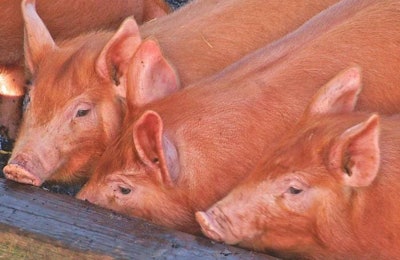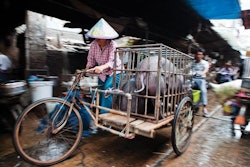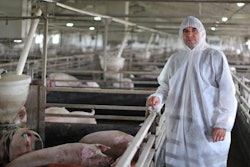
The African swine fever (ASF) situation in Vietnam has deteriorated to the point where a senior politician is encouraging the country’s pig farmers to switch to the production of poultry or cattle, while new outbreaks of the disease have also been reported in domestic pigs in China, Poland, Romania, Russia, South Africa and Ukraine.
In the past week, there have been three new ASF outbreaks in Vietnam, all occurring as clusters in village pig herds. With total direct losses of 434 animals as the result of culling to prevent further spread of the infection, latest cases were in the provinces of Dak Nong and Lam Dong in the Central Highlands region, and Vung Tau in the Southeastern region, according to official reports from the agriculture ministry in Hanoi to the World Organisation for Animal Health (OIE).
The stark reality of the disease situation in Vietnam has emerged in a report from VN Express, which refers to the culling so far of 2.83 million pigs, and losses estimated at more than VND3.6 trillion (US$155 million).
Just three of Vietnam’s 63 provinces and cities have not so far declared outbreaks of the disease, which began in early February.
According to Hanoi People’s Committee, ASF has spread from small family herds to commercial farms, and the number of infected pigs culled in the city has jumped from 6,000 to 10,000 per week. Almost one in three of the area’s farming households have lost their animals to the disease.
ASF could dramatically change the pattern of farming in Vietnam, where pork used to account for 70% of the total meat production, reports Vietnam News.
Both to control ASF and diversify the country’s food sources, farmers should consider switching from raising pigs to poultry or grass-fed cattle or buffalo, according to Nguyen Xuan Duong, director of the livestock department of the agriculture ministry.
“For areas that are suffering from African swine fever, to be honest, we are reluctant to advise farmers to resume their pig farming, because the virus remains in the air and the disease is unpredictable,” he said.
China: New ASF outbreaks in two provinces
After an apparent absence of five months, ASF has returned to the central Chinese province of Qinghai. A backyard herd tested positive for the virus last week after 17 of the animals died. Source of the infection in this outbreak is unknown.
The number of outbreaks in the southern province of Guizhou has risen to seven, with the reporting of cases at five new locations by the agriculture ministry to the OIE in the past week. All 927 cases were in Buyi and Miao Autonomous Prefecture, in four districts. One farm, two backyard herds, and two neighboring village herds were affected.
Asia’s pig farmers on ASF alert
With ASF already present in six Asian countries — Cambodia, China, Laos, Mongolia, North Korea, Vietnam — other Asian states are on alert for signs of the disease, and taking steps to prevent the infection.
In Malaysia, pig farm owners will face fines up to MYR25,000 (US$6,030) if they fail to report symptoms of ASF or unusually high mortality in their animals, reports Channel News Asia.
When ASF was discovered in Laos this month, Thailand immediately banned imports of all live pigs and carcasses from its neighbor for at least 90 days, according to Nikkei Asia Review.
The government of Laos is reported by The Nation to have thanked Thailand for sending supplies of disinfectants and application equipment soon after the first outbreak was announced. The ASF outbreaks in Laos are just 200 kilometers from the Thai border.
In the past week, disinfectant spraying has begun of trucks at the border on the Thai-Lao Friendship Bridge, according to the same source. Thai authorities are targeting vehicles returning after delivering pigs and pork products to Laos.
The Thai cabinet approved a budget of almost 150 million baht (THB; US4.8 million) over three years for measures to prevent ASF from entering the country, reported The Nation in April of this year.
ASF confirmed at two more Polish farms
In mid-June, ASF was confirmed at two more farms in Poland, according to an official report to the OIE from the national animal health agency. In Lublin province, the virus was detected following the death of one pig out of a herd of 24 animals, and after five pigs showed signs of the disease at a farm in Warmia-Masuria. Because of previous outbreaks of ASF in wild boar in these provinces, the area is already subject to special restrictions for disease control.
These latest outbreaks bring the country’s total number of farms affected by ASF to seven.
Romania, Russia, Ukraine report new ASF cases in 'backyard' herds
In a series of reports over the past week, the veterinary authority of Romania has confirmed a total of 26 new ASF outbreaks to the OIE, directly affecting 229 pigs. These belonged to backyard herds ranging in size from one to 40 animals, and in counties in the south, southeast, northeast and northwest of the country, where previous cases have been confirmed.
Ukraine’s animal health agency has reported to the OIE three recent ASF outbreaks in small backyard herds. Affecting a herd of 22 pigs, the first was in Kharkiv oblast in the north-east of the country, where the virus had not been detected for three months. Another outbreak affected a single pig in the southern province of Kherson, where the virus was last confirmed in a wild boar in December last year, while the third outbreak was in a two-pig backyard herd in the south-western province of Donetsk.
Following a periods without ASF outbreaks or detection of the virus, the Ukrainian service for food safety has declared to the OIE that the disease situation has been “resolved” in Vinnytsia and Ternopil in the west of the country, Sumy in the northeast, and Mykolaiv in the south.
In mid-June, the ASF virus was detected in a backyard herd of two animals in Novgorod oblast in the Northwestern Federal District, according to the latest report from the Russian agriculture ministry to the OIE.
Source of the infection is unknown, but the authorities appear to be linking the outbreak to one occurring one month earlier in the Republic of Adygea, which is in Russia’s Southern Federal District.
ASF hits another village herd in South Africa’s Free State
South Africa’s total ASF outbreaks has reached nine, as the agriculture department has informed the OIE about one new outbreak of the disease. This was confirmed in mid-June in a village herd in the Ngwathe district of Free State. The virus was detected in the same district last month.
As with all the country’s ASF outbreaks since mid-April, the latest cases were in an area outside South Africa’s ASF Control Zone.
More ASF in European wild boar
According to official reports to the OIE from the respective animal health agencies, ASF has been confirmed in new cases in wild boar in four countries in the past week.
Covering a period from March 26 to April 15, Poland’s agriculture ministry has confirmed the virus in 124 wild boar on 77 occasions at locations in the previously affected provinces of Lublin, Masovia and Warmia-Masuria.
In Hungary, 19 animals were found to be positive for the virus in the northern county of Heves at the end of May. More recently — during the third week of June — 16 wild boar were found to have been infected with the disease in Romania, and a further five in Latvia.
Belgium’s veterinary agency has not reported any new cases of ASF in wild boar to the OIE in the past week. According to official web site of Wallonia — the region where all outbreaks so far have occurred — 823 of the animals have tested positive for the ASF virus out of 3,166 tested between the first case in September last year, and June 24.
View our continuing coverage of the African swine fever outbreak.

















